Looking for a good pate recipe for venison liver (or any liver for that matter?) here you go, this is my go-to. This is basically the same recipe I was taught by one of my old chefs, who learned it from a master butcher from Rome (Chef Fillipo Caffari).
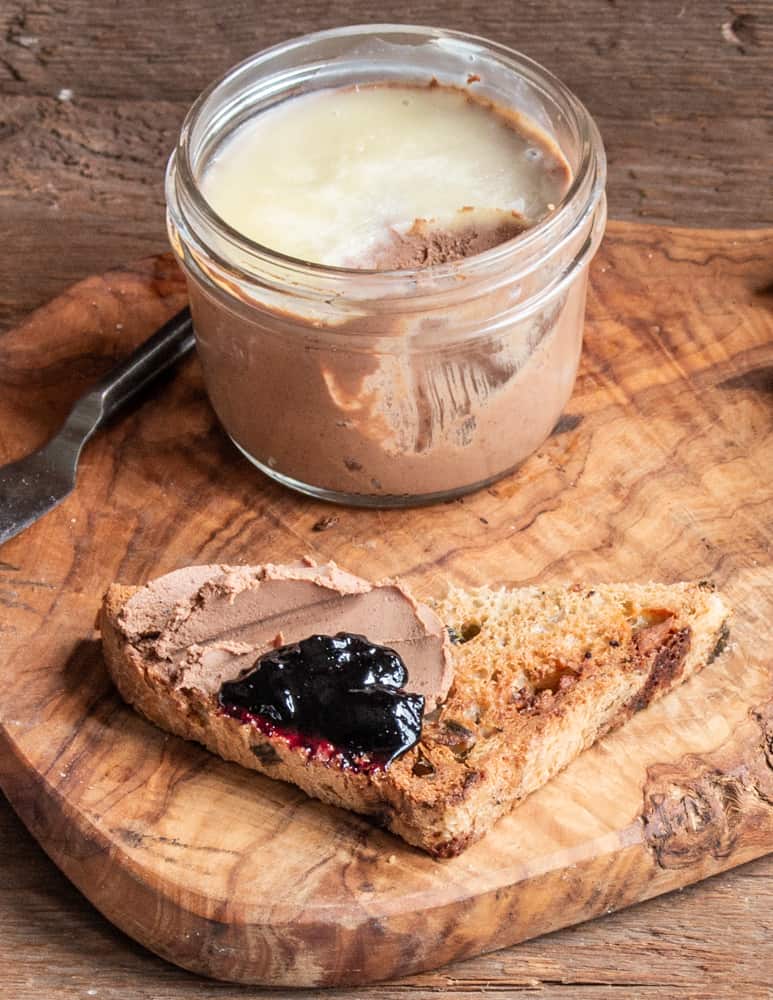
Mostly we would make it with poultry livers, but it's just as good made with livers from larger animals. The secret is a bit of apple cooked and pureed with the liver that helps cut it and underline the sweetness, along with plenty of butter and good toasted or grilled bread (cinnamon raisin toast is the perfect partner!).
Leeching liver: my secret trick
With venison, goat and lamb though, I do take some additional steps to calm the liver flavor, a kind of secret trick I developed. Often with liver, recipes may instruct you to soak the organ in milk or dairy, which works ok, but for me, is really a starting point to expand on.
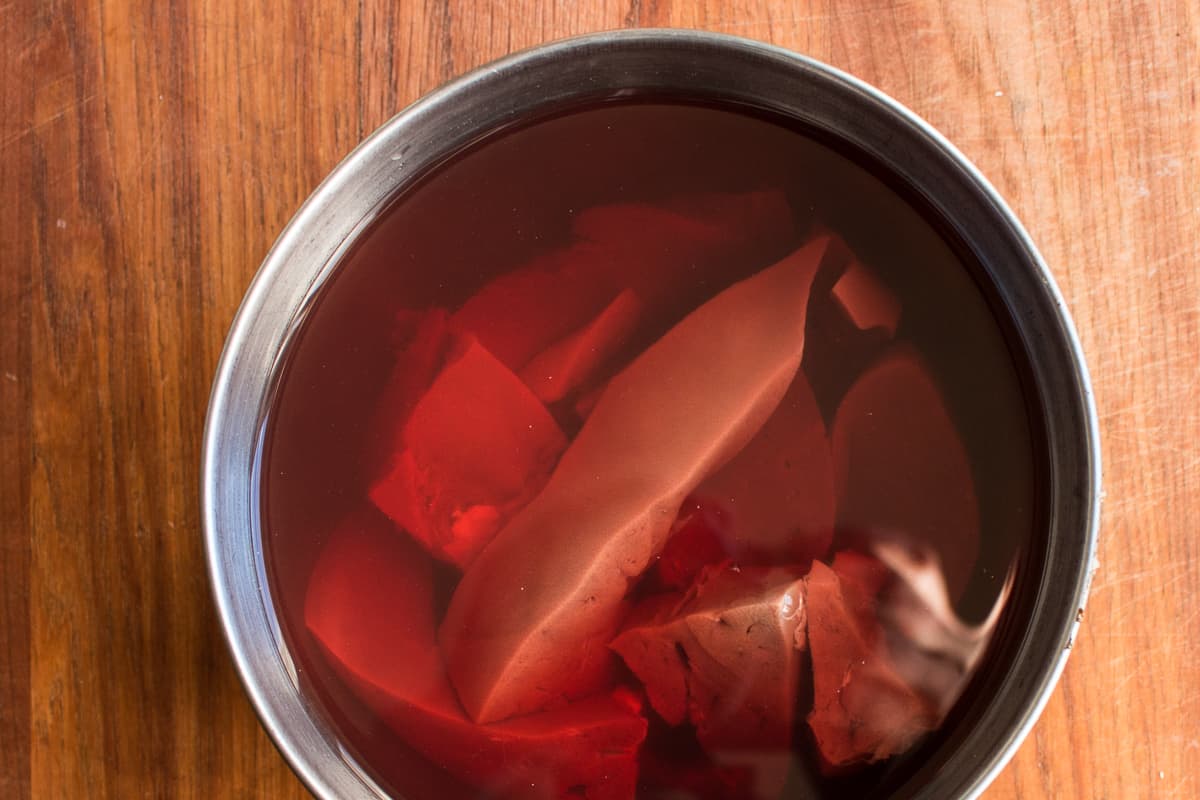
Soaking a liver in milk, especially if it's a whole liver, will soften some of the irony taste people associate with venison liver, but, if you really want to calm that flavor down, you can do what I do: soak it in multiple changes of water, with the liver cut into pieces, which is a more aggressive way of leeching out some of the irony taste.
Soaking the liver whole in multiple changes of water works, but cutting it into pieces first creates more surface area for the water to touch, which translates to a faster and more efficient dilution of the livers flavor. Pre-treating liver this way is powerful, and, you can remove the flavor so much that the liver can almost be tasteless, for better or worse.
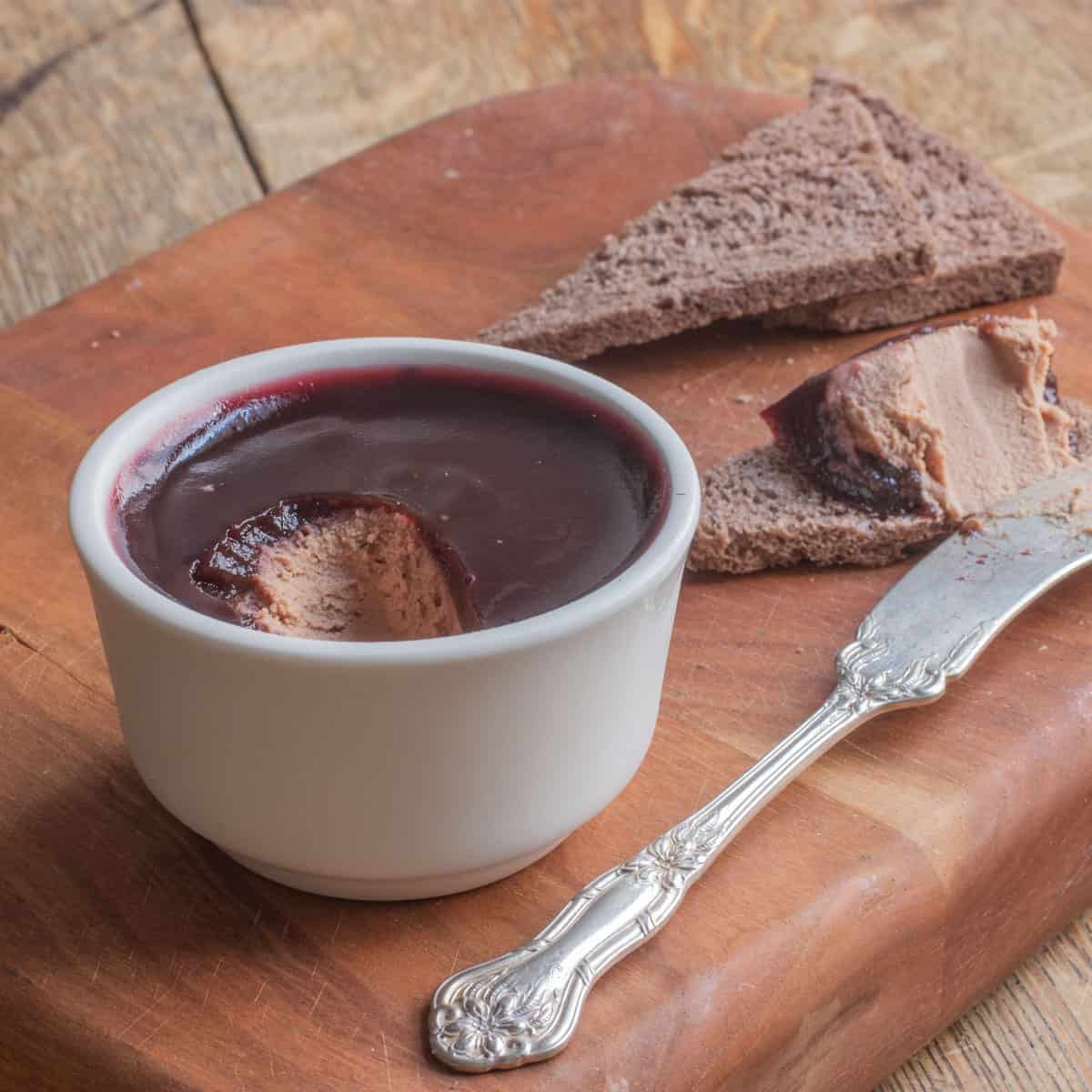
For an experiment, you can try cooking and tasting pieces of the liver throughout the leeching process to see what I'm talking about here, the flavor change is real-try it and let me know what you think. I like to serve liver pate with sweet things, like jam or chokecherry jelly, as well as toast with fruit in it-your favorite cinnamon raisin bread, toasted up crisp, will be just fine.
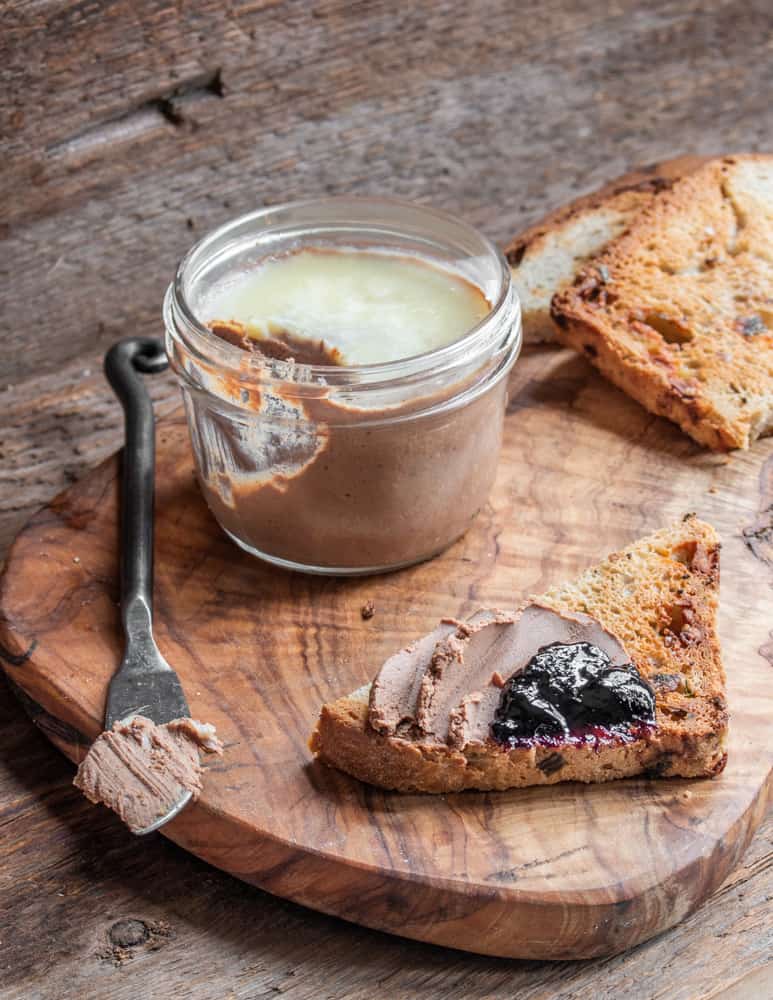
More Nose to Tail Venison Recipes
Venison Liver Pate
Ingredients
- 1 lb venison liver cut into 1 inch pieces
- ½ teaspoon pink salt sodium nitrite (optional, this preserves the color)
- Tart crab apples or other apples peeled and diced to yield 2 cups (8 oz)
- ½ cup cognac or brandy
- 1 cup 4 oz yellow sweet onion, diced
- 2 Tablespoons flavorless cooking oil for browning the liver
- 6 oz 1.5 sticks, unsalted butter, chilled and diced
- ½ teaspoon kosher salt plus more to taste
- 1 tablespoon maple syrup
- ⅓ cup heavy cream warmed
- 10 scrapes of nutmeg optional
- High heat cooking oil as needed for browning the livers
Instructions
Leeching the liver
- Cover the pieces of venison liver in cold water to cover by twice their volume, put a lid on the container, and refrigerate for 24 hours, changing the water, 2-3 times during the process, or every 8 hours, or as often as you can remember. Consider setting a timer.
Cooking and preparing
- Remove the liver from water, then pat dry. Heat a pan with a small amount of oil, then brown the liver pieces well. Add the apples and onions adding a little water to the pan if it threatens to get too dark. Cook until the apples and onions are completely cooked and starting to color, about 5-10 minutes.
- Add the cognac or brandy and flambee the mixture, then cook until almost all the liquid has evaporated. Puree the mixture in a highspeed blender, or food processor, adding the pink salt, maple syrup, kosher salt and pepper to taste, gradually adding the diced, cold butter and the cream until the mixture is very smooth.
- Pass the mixture through a chinois strainer (optional) add the nutmeg, taste and adjust the seasoning, then place in a labeled, dated, container. Cover the pate with plastic wrap, pressing it down onto the pate to prevent oxidization if refrigerating.
- The pate will keep in the fridge for 3 days, or it can be frozen. I like to portion the pate into 1 cup ramekins, covering them with a film of melted butter or fruit jam to prevent oxidization.

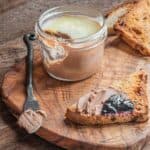
Jim Croghan
Hello - just to confirm.. you care cooking the liver completely through right? If you brown it and leave it in for 10 minutes with the apple and onion I assume it will s completely cooked?
Alan Bergo
Yes the liver must be completely cooked through, 10 minutes is ample time to do that.
Garrett
Is this pink salt #1 or #2? I'm assuming #1? I'm trying this tonight.
Alan Bergo
Hey Garrett. It’s no1. IC #1 is used for things that will be cooked: ham, pate, bacon etc. IC #2 is for things like salami, bresaola, and long aged fermented charcuterie. I’ll make sure it’s obvious in the recipe, thanks for commenting and I’m here if you have more questions.
Kay
what is the purpose of using 2 kinds of salt?
Alan Bergo
Pink curing salt is not like regular salt and the two must never be substituted for each other for safety reasons. Pink curing salt (instacure no1) is the reason that every ham, hot dog, and slice of bacon you've ever eaten is pink instead of grey after cooking. It's used here purely for aesthetics and it's optional, but most restaurants will use it in theirs. If you're not familiar with it, skip it and it will be fine.
Ryan
I really love this recipe! I have made it a few times as I always save the liver from my deer. Just two quick questions. How long are you cooking the liver? Are you leaving it in the pan when you add apples and onions or taking it out. Also how would I make it more “livery”? Just add another quarter pound of liver? Thanks for awesome recipe!
Alan Bergo
Hi Ryan, thanks for commenting-glad you like it. You are leaving the liver in the pan, and it should be well-browned. Hopefully I can make a video of it this year. As for making it more livery, you would simply soak a whole liver in milk instead of water vs cutting it into pieces.
Luke
Hi there, I am a hunter who has always discarded offal, but love pate from the shops. I just have it a go with a liver of a young fallow (8/9 months old) that I shot 6 days ago and the smell during cooking was quite off putting. Have I left it too late with the liver and is there a chance it spoilt in 6 days? The liver was in a fridge within 30 minutes of the kill and deer wax neck shot so no gut spoilage of any sort. I put it in the jars and will try once more when cooled. Keen to hear your thoughts.
Alan Bergo
Hi Luke, our sense of smell is a natural defense against ingesting things that could make us sick. I have a giant buck leg in my fridge that was taken a week ago I'll process tmrw, but offal-hearts, livers, kidneys, fat, and everything else has a much shorter shelf life than meat. It should be processed or frozen ASAP after harvesting and can't sit around like whole muscles can. I would try again next year with a very fresh liver.
Adele Vaverchak
I am using this recipe tonight on a huge liver of a buck. Too tough to fry and eat. Thanks for the suggestions and recipe.
Alan Bergo
Thanks Adele. Yeah venison liver can be tricky. I'll be cooking some up next weekend at deer camp.
Freyda Black
I am blessed with an abundance of venison livers, gifts from the hunters around here do not appreciate offal as I do. However, much as I love liver, calf, goat, sheep, or poultry, venison liver has always been just too bloody for me. Your soaking solution sounds wonderful and I look forward to trying it, and this recipe for pate, right away (deer season is open and liver is waiting in the refrigerator!)
I have a question about substitutions. For cultural reasons, I simply cannot use dairy products with meat. What would you recommend as a substitute for the butter and cream? There are many "plant butters" out there, although olive oil is my favorite, or perhaps rendered duck or chicken fat? The cream is what stumps me. Is it necessary to find a substitute? Should I risk something like cashew cream? I am not sure what quality it adds to the pate that it would then lack. I grew up eating "chopped liver", made with onions and grebens (diced chicken skin fried crisp in chicken fat), which I still consider heavenly.
Alan Bergo
Hey Freyda. The purpose of the cream and butter is to add fat, and to keep the pate spreadable when it's cooled-otherwise it would be grainy. As long as whatever you're adding has fat it should work. Instead of butter I would absolutely add rendered poultry fat-that's probably the best substitute for the butter.
Lyana Snow
For those that don’t consume any alcohol, what would you suggest using in place of the cognac or brandy?
Alan Bergo
Hi. If it isn’t clear, you’re not consuming any alcohol here as it’s all cooked off during the process and evaporates. If you had to you could deglaze with a splash of chicken stock, but I’d prefer to borrow a splash from neighbor as there really isn’t a substitute, and a deglaze of brandy or cognac goes into every pate I’ve ever made.
Lyana Snow
For those that don’t consume any alcohol, what would you suggest using in place of the cognac or rum?
Alan Bergo
I would borrow a cup from a neighbor, or skip it.
Chantelle
Hi Alan. When do I add the maple syrup?
Thanks
Chantelle
Alan Bergo
Hi Chantelle. It's added at the end with the salt.
William L McGinnis
Good news: you won't be consuming alcohol. The flambe step destroys the ethanol, and all you're left with is the flavor.
Alan Bergo
Thanks for chiming in William.
Nick Robinson
I love this recipe, it’s a game changer for venison pate, I have made it three times now with the latest using a kilo of liver. I use Roe livers and find that I prefer 8 hours leeching as they aren’t too strong and I like some flavour left but it’s worth experimenting for personal taste. I usually change ingredients in recipes as I use them but the results of this one are so good I tend to stick to your recipe. It’s very popular with friends and family.
Alan Bergo
Thanks Nick.
AJ
Why the pink salt? Can a person substitute for kosher salt? It's is nor cured, so that's why I'm asking.
Alan Bergo
IF you don't have some just skip it, which is why it's listed as optional. It's for color, but it will also extend the shelf life and improve the flavor a little.
Dave Wygonowski
A little celery seed powder works also, instead of the chemical version. Use it in my kielbasa.
Alan Bergo
FYI, celery is a natural source of nitrites-literally the same thing as pink salt. Lovage too. The only difference is that plants have a variable amount of the compound. Celery seed will also ruin the flavor added in a quantity large enough to color the pate.
Poly
Awesome..
I just discovered your site because of the fermented knotweed head recepies. Japanese knotweed or P. cuspidatum is an amazing medicinal powerhouse of a plant but in the west mostly seen as a huge pain in the butt ; p
I really like your weeds and herbs uses and the culinary offal and organ recipes that are so powerful n nutricious to mankind and yummie too I might add. Oldschool rules and never dies no!?
Way to go bruv and I'm curious about the development of the book series.
Thanx much for the succulent info and much Respect!
P.